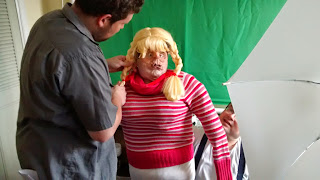As mentioned earlier, Jon's blog has ace coverage of the filming of our first video, so rather than repeat it here, I thought I'd first of all chuck in a few photos of the sculpting process and some behind-the-scenes images that amused me, and then explain a bit about the construction process afterwards, so as not to bore the casual browser...
Right, that's the pretty pictures done with, now for the boring bit which you can conveniently skip if you like...
As ever, the puppet starts off as a clay sculpture, using bog-standard (and cheap) water-based clay. From this, a plaster mould is then made, much the same as with the Nick Griffin head. However, when it came to casting, rather than a thin latex skin filled with soft polyurethane foam, I tried a different approach. With Nick, I found that filling the head completely with (even soft) foam made it stiff and difficult to manipulate, so for Nigel I made a thick rubber skin, formed by leaving the latex in the mould for six hours to build up a skin around an eighth of an inch thick, with the intention of leaving the moving parts (the mouth) empty and retaining their shape solely by virtue of the thickness of the rubber skin.
As such, I just filled the inside of the top of the head with foam, leaving the mouth downwards empty. Inside the upper and lower jaws I glued 'mouth plates', rigid plates made from 3mm thick styrene sheet with elastic fabric straps attached into which the puppeteer slips their fingers (upper jaw) and thumb (lower jaw). A few chunks of furniture foam were cut to shape and inserted to provide more support for the puppeteer's hand and voila! A puppet head was born!
The body was cobbled together from plumbers' plastic pipe, furniture foam and a pillow(!), with a couple of ropes looped out of the neck. These were then placed over the puppeteer's hand (between thumb and fingers) so that the puppet torso hung from the head at the right level. This proved knackering, and a great strain on the puppeteer (me), because the one hand and arm have to support (and manipulate) not only the head but the body too, so a better arrangement will be made for future use. Some sort of harness to be worn about the puppeteer's body will be needed to support the puppet torso's lower edge, thus taking most of the weight, whilst the ropes at the neck will be replaced with some kind of fabric webbing.
And that's about it for now.
Tuesday, 20 May 2014
Subscribe to:
Post Comments (Atom)









No comments:
Post a Comment